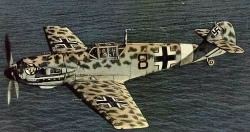| The Effect of the North American P-51 Mustang On the Air War in Europe by David Buckingham |
||||
|
P-51's Give Bombers Better Support Another profound effect that the increased fighter coverage had was on the most important people, the bombers. After the entrance of the P-51, and the virtual elimination of the German fighter threat, the bombers were in much less danger from German fighters. The result of the decreased danger to the bombers is subtle, but obvious when considered. Imagine a bomber crew sitting in their cramped plane, unable to move around or evade attack during their bombing run while numerous German fighters speed past their plane firing at them. Second Lieutenant William Brick, the bombardier of a B-17 bomber, tells about the day he flew to Linz, Austria on a bombing run: " . . . The remainder of the run must be perfectly straight and level, without the slightest deviation, or our five-thousand-pound bomb load will fall wide of the target. No evasive action is possible. . . Then comes the sickening rattle of machine-gun bullets and cannon fire hitting our ship; ignoring the flak from the antiaircraft batteries, German fighter planes zoom in so close that it seems they will ram us. . .
 Me109 in Desert Colors Even at the sub-zero temperatures of this altitude, salty sweat pours down my face and burns my eyeballs. Cursing and praying, I am gripped by the same brand of helpless fear that fliers experience during every bomb run. I feel the terror in my hands, in my stomach, even in my feet. Long after returning from the mission, its effects will remain etched indelibly on my face. . . . "(Brick 61) This kind of terror experienced by the entire crew of the bombers was sure to affect their concentration and their carefulness. Indeed, "it is an undeniable, if unquantifiable, fact that it is easier to bomb precisely when you know you will probably not be shot out of the sky." (Boyne 341) |
Conclusion In the end, the way that the Allied air forces gained air superiority was by destroying their opposition. The ways in which the fighters were able to destroy German fighters were diverse. The fighters utilized their high speed and maneuverability to fly low-level strafing missions that ranged over large expanses of territory and destroyed many Luftwaffe craft on the ground. This tactic was responsible for the destruction of many dozens of fighters that were unable to go on and fight in the air. Another way that the Allied fighters destroyed their opposition, and the most important way, was by luring them into the air. Going back to the hornets' nest analogy, the Allies stopped pushing the stick and decided to bide their time until the moment was right. When they did start pushing the stick into the nest again, they were armed with a metaphoric insecticide. In real life, this "insecticide" was the P-51. Beforehand, the Allies had nothing that could stop the "hornets" and so were helpless to stop their attack. But after they had developed an "insecticide" capable of killing the "hornets," they proceeded to lure the hornets into the open where they could be destroyed. In reality, the bombers were the lure that brought the Luftwaffe into the air. Using the long-range Mustangs, the Allies were able to make their bombing raids more effective and more deadly to Germany. The approaching end of the Third Reich was enough to get the German fighters into the air to try to stop the bombers from wrecking their war effort. "Air superiority had been won not by bombing the enemy's factories into oblivion; instead, it was won by the long-range fighter, using the bomber formations as bait to entice the Luftwaffe to fight." (Boyne 338) With the advent of great numbers of the highly superior P-51 Mustang, the German fighters that came up to attack the bombers quickly met their match and were easily repelled by the Mustangs. Go to BIBLIOGRAPHY Join a discussion forum on this article by clicking HERE.
|
|||
|
Copyright © 1997 - 2000 COMBATSIM.COM, INC. All Rights Reserved. Last Updated August 27th, 1999 |
||||
